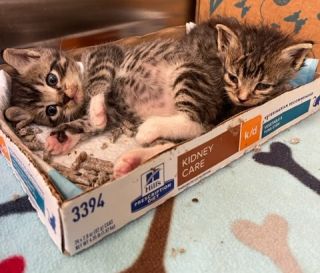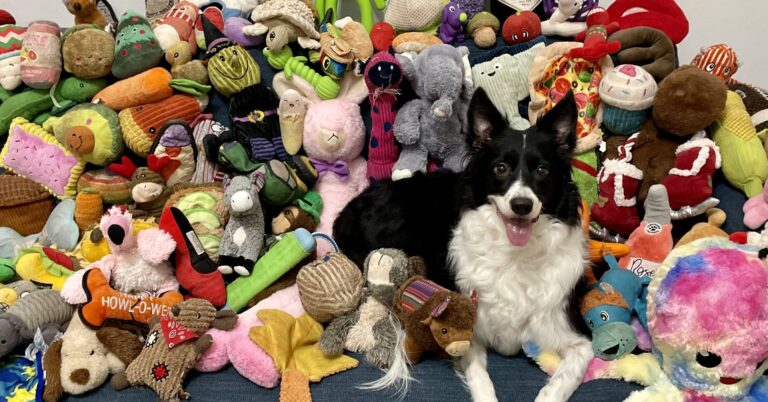
Stray kittens waiting for a foster.
Source: Sarah Hoggan DVM
During the COVID-19 pandemic, people sheltered in place and took stock in what made them feel comfortable: baking bread, living in pajamas, and the company of an animal companion.
Pet adoptions soared so much during the pandemic that shelters actually ran out of adoptable dogs and cats. Tragically, that phenomenon has passed, and now a large portion of the shelters in the United States are filled so far above capacity that they cannot accept any more animals.1
While the variables leading to overcrowding are many, they can be broken down into two basic categories: issues with shelter facilities, and/or issues with the pets or the people who brought them there.
Shelter Facility Issues
Government funding for animal control is limited at best. Many of the shelters in the United States were built prior to adoption of “no-kill” policies. Before these policies were in place, at times of crowding, shelters would euthanize more animals to make room. As the goal of saving as many healthy animals as possible became the public’s expectation, using scheduled culls to manage the population fell out of favor. Without major funding to build additional housing, or alternative locations to occupy, crowding and putting multiple puppies into cages designed for cats became the reality.1
Granted, foster networks, rescue organizations, and other grassroots groups do their best to house some of the animals until they can find forever homes, but currently, many of those groups are also overwhelmed because the demand for their services is so much higher than their capabilities.1
Pet/Human Issues
For pets and humans to cohabitate, there must be a mutually beneficial relationship. If a pet’s behavior sabotages that relationship, then their housing situation become tenuous.
The behaviors that most often result in animals being taken to the shelter are either destructive behavior, such as soiling or chewing, or aggressive behavior.2 Aggression is a broad category and may mean aggression directed at other animals, children, strangers, or certain adults in the home.
Some animals find their way to the shelter because they have a medical condition the family can no longer afford to manage. They may not have the time or financial resources, so they take the animals to a shelter, hoping someone will be willing to adopt a “special needs” pet.

A blind dog found abandoned at a park.
Sarah Hoggan DVM
Tragically, these animals are frequently very difficult for a shelter to rehome and they end up either living in shelter situations for years, or being euthanized because their condition may be manageable, but they are still deemed “unadoptable” because no one is willing to take them.
Death of an Owner
In senior communities, it is common for animals to be taken to a shelter when their owner passes away if rehoming plans were not already in place. Initially, pets are offered to immediate family/friends. If no one accepts, then the pet goes to the shelter. They are treated this way because, in the eyes of the law, pets are “things”—just another object that needs to be sorted.
These cases are often heartbreaking to see because the pet is typically used to a quiet lifestyle where they were doted upon. Suddenly they are alone, their one person “pack” is gone, and they are living in a completely foreign environment filled with loud noises, sharp smells, and strangers.
These are often the dogs you see cowering in the back corner of their cage, completely confused and overwhelmed. They become despondent and shut down. Sometimes they are euthanized as an act of mercy, versus watching them languish in sadness.
Lost Pets
Of course, there is a population of pets that were found as “strays” and brought in off the street. These animals may have accidentally escaped their home, been dumped at park or grocery store, or been left behind intentionally when their family moved away.
Breeder Release
Some animals are brought to a shelter because they are no longer profitable. A dog that was used in a breeding program that can no longer get pregnant is considered a financial drag on the business.
A litter of kittens that was conceived accidentally in the middle of “kitten season” are not a rare commodity to sell. Finding a new home takes time and effort. Taking them to a shelter is considered a problem solved by some individuals.
Pet No Longer Fits
Finally, one of the most common, and most tragic scenarios, for pets arriving at the shelter is due to a life circumstance change of the family. The pet was not destructive or aggressive, they were not lost, and they didn’t do anything wrong. Their family’s circumstances just changed and they either cannot stay with them or their family no longer has time for them.
This scenario is played out in shelters every day. On the intake form the explanations range from one word: divorce, moving, college, to impassioned pleas to take care of a pet that is clearly loved: “We lost our house; the new place won’t accept pets. He is the best boy!”
Like most chronic issues in society, there is more than one cause of the shelter overcrowding problem; it is the byproduct of multiple variables that share a common denominator: If a pet can’t be kept, it has to go somewhere. Unfortunately, the last stop on “the road to somewhere” is a shelter.

A pregnant Labrador, just rescued from a shelter and still adjusting.
Source: Sarah Hoggan DVM
While this problem is chronic and complex, it is not impossible to improve.
Approximately 44 percent of American families have pets. Of that percentage, roughly 36 percent purchased their pet from a breeder.2 If more people would go to shelters first and look at adopting adult dogs and cats instead of puppies or kittens, the business of breeding pets would become less alluring. Then, instead of paying thousands of dollars for a purebred, people could invest a fraction of that money toward a shelter pet’s training and basic veterinary care. With that single change, money and lives could be saved.
If more people would be willing to foster animals, to give them a home while they await their forever home, then shelter crowding could be diminished.
Finally, the greatest change would be a hard reset of people’s perception that pets are “things.” Things are bought on a whim; things are thrown away when they are no longer in fashion or an upgraded model is available; things have no feelings or needs, and are incapable of reproducing. Pets are animals: mammals, birds, reptiles, and fish. They have the ability to feel pain, be it physical injury or mental anguish.
The pandemic gave people time to play with “things.” Now there are thousands of animals waiting in shelters because they are not things.


















+ There are no comments
Add yours